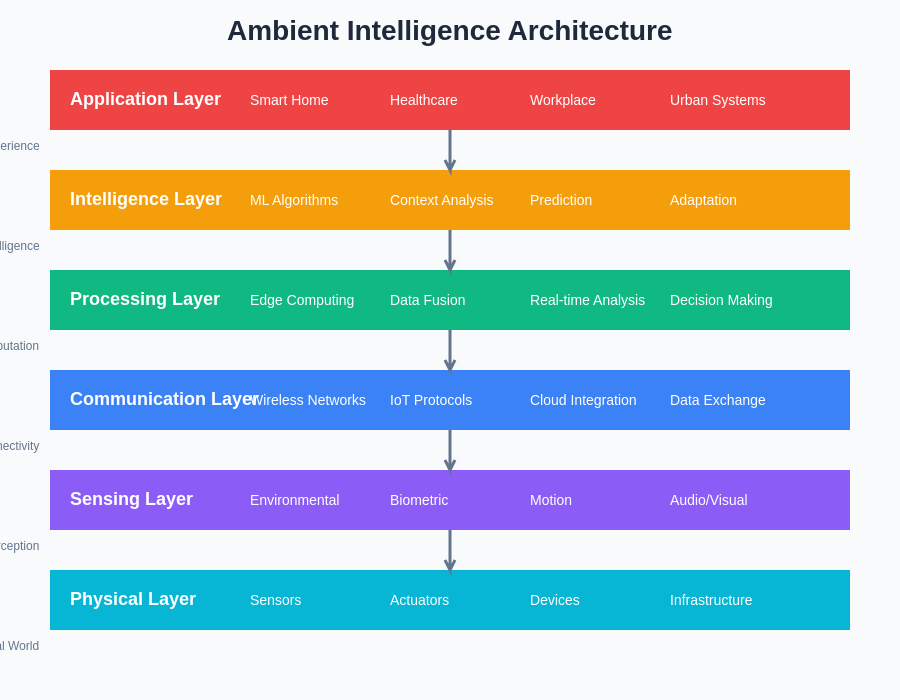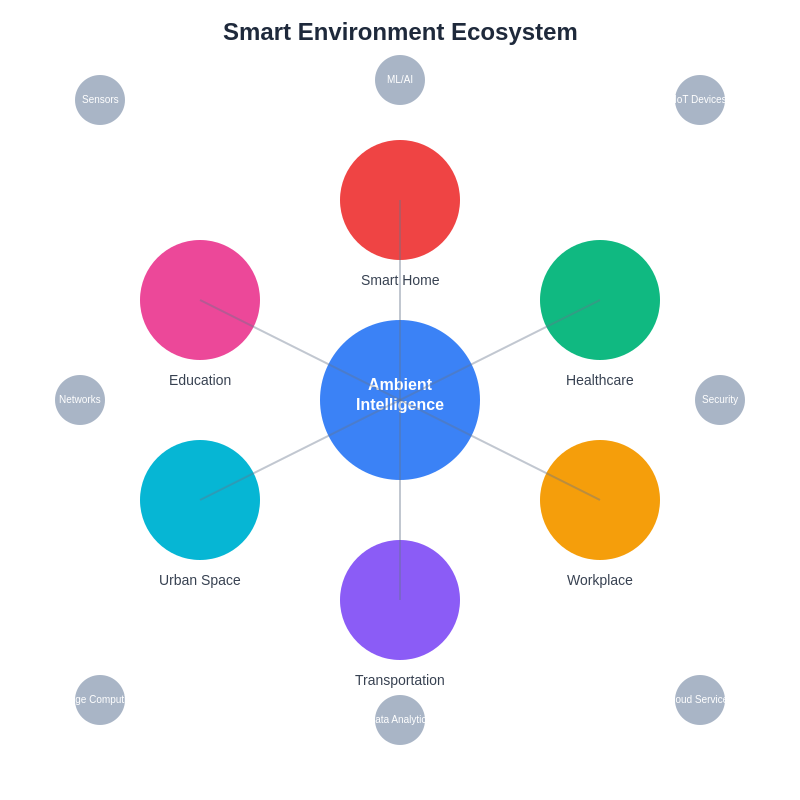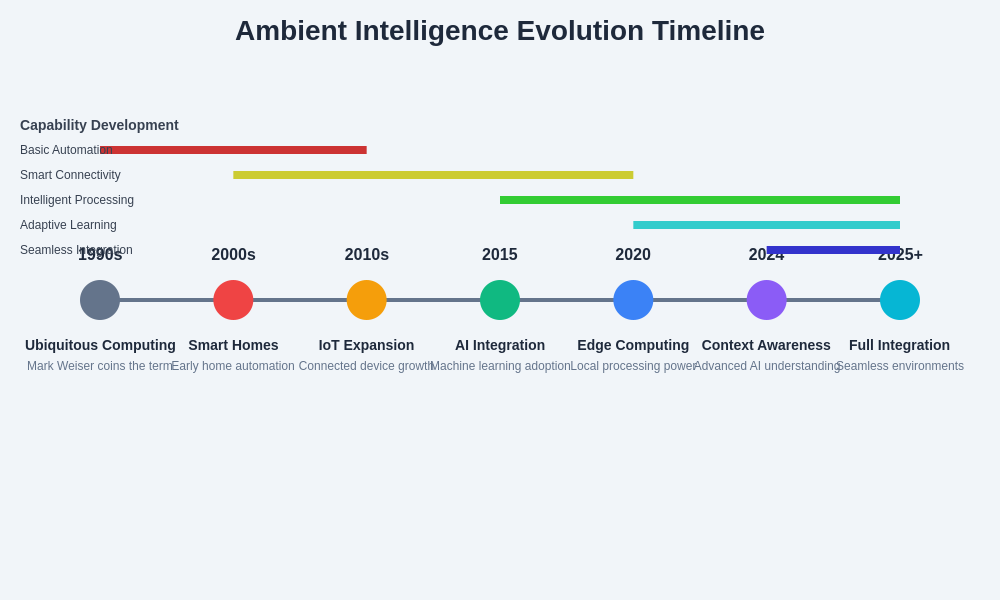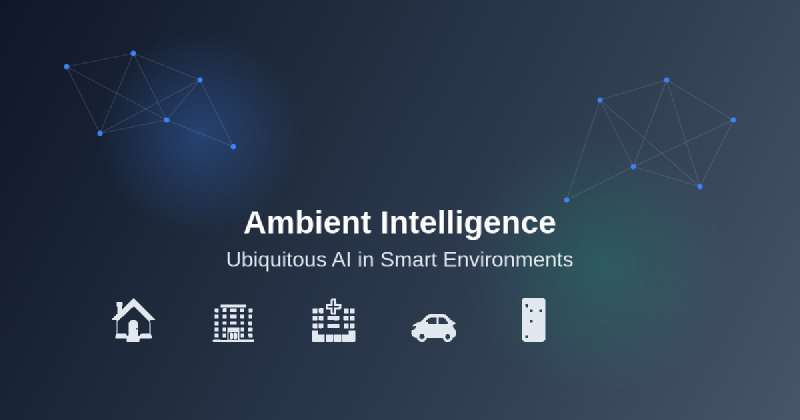The vision of seamlessly integrated artificial intelligence that operates invisibly within our everyday environments has evolved from science fiction to tangible reality through the emergence of ambient intelligence. This revolutionary paradigm represents a fundamental shift from traditional human-computer interaction models toward intelligent environments that proactively understand, anticipate, and respond to human needs without explicit instruction or conscious awareness. Ambient intelligence transforms ordinary spaces into responsive ecosystems that enhance quality of life through sophisticated contextual awareness and adaptive behavior patterns.
Discover the latest trends in AI development to understand how ambient intelligence is shaping the future of human-technology interaction in ways that were previously unimaginable. The convergence of ubiquitous computing, advanced sensor networks, and sophisticated machine learning algorithms has created unprecedented opportunities for creating truly intelligent environments that seamlessly blend digital capabilities with physical spaces.
Foundational Principles of Ambient Intelligence
Ambient intelligence operates on several core principles that distinguish it from conventional computing paradigms and establish the foundation for truly ubiquitous intelligent systems. The first principle centers on invisibility, where technology becomes so seamlessly integrated into the environment that users interact with intelligent systems naturally without conscious awareness of the underlying technological complexity. This invisibility extends beyond mere physical concealment to encompass intuitive interaction patterns that align with natural human behavior and expectations.
The second foundational principle involves contextual sensitivity, where ambient intelligent systems continuously gather and analyze environmental data to understand situational context, user preferences, and behavioral patterns. This deep contextual understanding enables systems to make informed decisions about when and how to provide assistance, ensuring that interventions are timely, relevant, and non-intrusive. The system’s ability to interpret complex contextual cues from multiple data sources creates opportunities for highly personalized and adaptive responses.
Proactive adaptation represents the third critical principle, distinguishing ambient intelligence from reactive systems by enabling environments to anticipate user needs and preferences before explicit requests are made. This anticipatory capability relies on sophisticated pattern recognition, predictive modeling, and machine learning algorithms that continuously refine their understanding of user behavior and environmental dynamics. The result is an intelligent environment that evolves and improves its responsiveness over time through continuous learning and adaptation.
Technological Infrastructure and Components
The implementation of ambient intelligence requires a sophisticated technological infrastructure comprising multiple interconnected components that work harmoniously to create seamless intelligent experiences. Advanced sensor networks form the sensory foundation of ambient intelligence, utilizing diverse sensor types including environmental sensors for temperature, humidity, and air quality monitoring, motion sensors for occupancy detection and behavioral analysis, biometric sensors for health monitoring and identity verification, and audio sensors for voice recognition and ambient sound analysis.
Edge computing architectures play a crucial role in enabling real-time processing and decision-making capabilities within ambient intelligent environments. By distributing computational resources throughout the environment, edge computing reduces latency, improves responsiveness, and enhances privacy by processing sensitive data locally rather than transmitting it to remote cloud servers. This distributed approach enables ambient systems to operate effectively even when network connectivity is limited or compromised.
Experience advanced AI capabilities with Claude for developing sophisticated ambient intelligence systems that require complex reasoning and contextual understanding. The integration of advanced AI models with ambient computing infrastructure creates opportunities for developing more intelligent and responsive environmental systems that can handle complex decision-making scenarios.
Wireless communication protocols and networking technologies provide the connectivity backbone that enables seamless information sharing between distributed components within ambient intelligent environments. These communication systems must support diverse device types, maintain reliable connections across varying environmental conditions, and accommodate the bandwidth requirements of multimedia data streams while ensuring low power consumption for battery-operated devices.
Smart Home Evolution and Integration
The smart home represents one of the most visible and rapidly evolving applications of ambient intelligence, transforming residential environments into responsive ecosystems that adapt to occupant preferences and behavioral patterns. Modern smart homes integrate diverse intelligent systems including climate control that automatically adjusts temperature and humidity based on occupancy patterns and external weather conditions, lighting systems that optimize illumination levels and color temperatures to support circadian rhythms and activity requirements, and security systems that provide comprehensive monitoring and threat detection through intelligent analysis of sensor data and behavioral patterns.
Entertainment and media systems within ambient intelligent homes create personalized experiences by understanding user preferences, viewing habits, and contextual factors such as time of day, occupancy levels, and ongoing activities. These systems can seamlessly transition content between devices, adjust audio levels based on environmental noise, and recommend content that aligns with current mood and situational context determined through environmental analysis and user behavior patterns.
Energy management represents a critical aspect of smart home ambient intelligence, where systems optimize energy consumption through intelligent scheduling of appliances, predictive load balancing, and integration with renewable energy sources. These systems analyze occupancy patterns, weather forecasts, and utility pricing to make informed decisions about energy usage that minimize environmental impact while maintaining comfort and convenience for occupants.
Healthcare Applications and Wellness Monitoring
Ambient intelligence has found particularly compelling applications in healthcare and wellness monitoring, where invisible monitoring systems can provide continuous health assessment without disrupting daily activities or requiring conscious user interaction. These systems utilize diverse sensing modalities to monitor vital signs, activity levels, sleep patterns, and behavioral indicators that provide comprehensive insights into individual health and wellness status.
Elderly care represents a significant application area where ambient intelligence can enhance independence and safety through continuous monitoring of activity patterns, fall detection, medication compliance tracking, and emergency response coordination. These systems can detect subtle changes in behavior or mobility that may indicate health concerns, enabling proactive intervention and support while preserving dignity and autonomy for older adults living independently.
Chronic disease management benefits significantly from ambient intelligence applications that provide continuous monitoring of relevant health parameters without requiring active user engagement. For conditions such as diabetes, hypertension, or heart disease, ambient systems can track relevant biomarkers, environmental factors, and behavioral patterns to provide healthcare providers with comprehensive longitudinal data that supports informed treatment decisions and early intervention when necessary.

The architectural framework of ambient intelligence systems demonstrates the complex integration of sensing, processing, communication, and actuation components that work together to create intelligent environmental responses. This multilayered approach ensures robust operation while maintaining the transparency and seamlessness that define effective ambient intelligence implementations.
Workplace Transformation and Productivity Enhancement
Modern workplace environments are increasingly incorporating ambient intelligence to enhance productivity, comfort, and collaboration while optimizing resource utilization and operational efficiency. Intelligent building systems monitor occupancy patterns, environmental conditions, and space utilization to automatically adjust lighting, temperature, and ventilation systems for optimal comfort and energy efficiency. These systems can also guide space allocation decisions and facility planning through detailed analysis of usage patterns and occupancy data.
Meeting and collaboration spaces benefit from ambient intelligence through automatic configuration of audio-visual systems, environmental controls, and communication tools based on meeting types, participant preferences, and scheduled activities. These intelligent spaces can adapt lighting and acoustics for different meeting formats, automatically connect participant devices, and provide seamless integration with remote collaboration tools based on contextual awareness of meeting requirements.
Explore advanced AI research capabilities with Perplexity to stay current with rapidly evolving ambient intelligence technologies and their applications in professional environments. The integration of advanced AI research tools with ambient intelligence development enables more sophisticated and effective workplace optimization strategies.
Workspace personalization through ambient intelligence allows individual workstations to adapt to user preferences and work patterns automatically. These systems can adjust desk height, monitor positioning, lighting conditions, and environmental controls based on user identification and historical preferences, creating personalized work environments that enhance comfort and productivity while reducing the cognitive load associated with manual environmental adjustments.
Urban Infrastructure and Smart Cities
The implementation of ambient intelligence at urban scale creates opportunities for developing more responsive, efficient, and sustainable city infrastructure that adapts to changing conditions and citizen needs. Smart traffic management systems utilize real-time data from diverse sources including vehicle sensors, pedestrian monitoring, weather conditions, and event schedules to optimize traffic flow, reduce congestion, and minimize environmental impact through intelligent signal timing and route recommendations.
Public transportation systems benefit from ambient intelligence through predictive maintenance, dynamic scheduling, and passenger experience optimization. These systems can anticipate service disruptions, adjust schedules based on demand patterns and external factors, and provide personalized information and recommendations to travelers through contextually aware information systems integrated throughout the transportation network.
Urban environmental monitoring represents a critical application of ambient intelligence in smart cities, where distributed sensor networks continuously assess air quality, noise levels, water quality, and other environmental factors that impact public health and quality of life. These monitoring systems enable proactive responses to environmental concerns and provide citizens with real-time information about environmental conditions that may affect their daily activities and health decisions.
Privacy, Security, and Ethical Considerations
The pervasive nature of ambient intelligence systems raises significant privacy and security concerns that must be addressed through comprehensive frameworks for data protection, user consent, and system security. The continuous collection of environmental and behavioral data creates opportunities for unprecedented insights into human behavior and preferences, but also presents risks for privacy violations and unauthorized surveillance if not properly managed through transparent policies and robust technical safeguards.
Data minimization principles become particularly important in ambient intelligence applications, where systems should collect only the minimum data necessary for their intended functionality and implement automatic deletion policies for data that is no longer needed. Edge processing and local data storage can help minimize privacy risks by reducing the transmission and centralized storage of sensitive personal information while maintaining system functionality and responsiveness.
User control and transparency mechanisms must provide individuals with meaningful choices about data collection, processing, and sharing within ambient intelligent environments. These mechanisms should include clear notification systems that inform users about active monitoring and data collection activities, granular control options that allow users to customize privacy settings based on their preferences and comfort levels, and easy access to personal data and processing activities for review and correction when necessary.

The interconnected ecosystem of smart environments demonstrates how ambient intelligence creates seamless integration between diverse technological components and human activities. This holistic approach ensures that intelligent systems enhance rather than complicate human experiences through thoughtful design and implementation.
Machine Learning and Adaptive Algorithms
The effectiveness of ambient intelligence systems depends heavily on sophisticated machine learning algorithms that can analyze complex, multi-dimensional data streams to understand patterns, predict behaviors, and make intelligent decisions in real-time. Unsupervised learning techniques play a particularly important role in ambient systems by enabling automatic discovery of behavioral patterns and anomalies without requiring extensive labeled training data or explicit programming of decision rules.
Reinforcement learning approaches allow ambient intelligence systems to improve their performance over time through interaction with users and environmental feedback. These systems can learn optimal policies for environmental control, resource allocation, and user interaction through continuous experimentation and adaptation, resulting in increasingly effective and personalized responses that align with user preferences and changing environmental conditions.
Federated learning techniques enable ambient intelligence systems to benefit from collective learning while preserving individual privacy and reducing data transmission requirements. Through federated approaches, multiple ambient systems can share learned insights and patterns without exchanging raw data, creating opportunities for improved system performance while maintaining privacy and reducing bandwidth requirements for system updates and improvements.
Integration Challenges and Technical Solutions
The integration of diverse technologies and systems within ambient intelligence environments presents significant technical challenges that require innovative solutions and careful architectural planning. Interoperability between devices from different manufacturers and systems with varying communication protocols requires the development of standardized interfaces and translation mechanisms that enable seamless information exchange and coordinated system behavior.
Scalability challenges arise as ambient intelligence systems grow from individual devices to complex ecosystems spanning multiple environments and involving thousands of interconnected components. Distributed architecture approaches, hierarchical control systems, and efficient data processing algorithms become essential for maintaining system performance and responsiveness as complexity increases and user demands evolve.
Reliability and fault tolerance mechanisms must ensure that ambient intelligence systems continue to operate effectively even when individual components fail or communication networks experience disruptions. Redundant sensing systems, graceful degradation strategies, and automatic recovery mechanisms help maintain essential functionality and user safety even under adverse conditions or system failures.
Future Developments and Emerging Trends
The future evolution of ambient intelligence promises even more sophisticated and seamlessly integrated intelligent environments through advances in artificial intelligence, sensor technology, and computational capabilities. Brain-computer interfaces may eventually enable direct neural interaction with ambient systems, creating opportunities for truly intuitive and effortless control of intelligent environments through thought alone.
Quantum computing applications in ambient intelligence could enable unprecedented computational capabilities for real-time analysis of complex environmental data and optimization of system responses across multiple variables and constraints simultaneously. These quantum-enhanced systems could solve optimization problems that are currently computationally intractable, leading to more efficient and effective ambient intelligence implementations.
Augmented reality integration with ambient intelligence creates opportunities for enhanced visualization of system status, environmental conditions, and available interactions through contextually appropriate visual overlays. This integration could make invisible ambient systems more transparent and controllable when desired while maintaining their seamless operation during normal use.

The evolution of ambient intelligence technology demonstrates the rapid progression from basic home automation to sophisticated, context-aware systems that seamlessly integrate with human activities. This timeline illustrates key milestones and projected future developments that will shape the ambient intelligence landscape.
Economic Impact and Market Development
The ambient intelligence market represents a rapidly growing economic sector with significant implications for multiple industries including technology manufacturing, real estate development, healthcare services, and urban planning. Market research indicates substantial growth potential as consumer awareness increases and technology costs decrease, making ambient intelligence solutions more accessible to broader market segments.
Investment in ambient intelligence research and development has attracted significant funding from both private investors and government agencies recognizing the transformative potential of these technologies. This investment supports continued innovation in sensor technology, artificial intelligence algorithms, and integration platforms that enable more sophisticated and cost-effective ambient intelligence solutions.
Job creation and workforce development needs associated with ambient intelligence implementation span multiple skill areas including system design and integration, data analysis and machine learning, privacy and security engineering, and user experience design. Educational institutions and training programs are adapting their curricula to prepare workers for these emerging opportunities in the ambient intelligence economy.
Global Perspectives and Cultural Considerations
The implementation of ambient intelligence varies significantly across different cultural contexts and regulatory environments, reflecting varying attitudes toward privacy, technology adoption, and social interaction patterns. European approaches tend to emphasize privacy protection and user control, resulting in ambient intelligence implementations that provide extensive transparency and user choice mechanisms.
Asian markets often demonstrate greater acceptance of data collection and automated decision-making, enabling more comprehensive ambient intelligence deployments that leverage extensive data analysis for system optimization and personalization. These cultural differences influence both the design of ambient intelligence systems and the regulatory frameworks that govern their deployment and operation.
Developing regions present unique opportunities and challenges for ambient intelligence implementation, where leapfrog technology adoption patterns may enable deployment of advanced ambient systems without requiring extensive legacy infrastructure upgrades. However, economic constraints and infrastructure limitations may require innovative approaches to make ambient intelligence accessible and beneficial in these contexts.
The global nature of ambient intelligence development requires international cooperation on standards, privacy protection, and security measures to ensure interoperability and protect user rights across different jurisdictions and cultural contexts. These collaborative efforts support the development of ambient intelligence solutions that can operate effectively in diverse global environments while respecting local values and regulations.
Conclusion and Future Outlook
Ambient intelligence represents a fundamental transformation in how humans interact with technology and environment, creating opportunities for more natural, intuitive, and beneficial relationships between people and intelligent systems. The continued evolution of this field promises to deliver increasingly sophisticated and seamlessly integrated solutions that enhance quality of life while addressing important challenges related to privacy, security, and social acceptance.
The successful implementation of ambient intelligence requires continued collaboration between technologists, policymakers, and communities to ensure that these powerful technologies serve human needs and values while respecting individual rights and social norms. As ambient intelligence systems become more prevalent and sophisticated, ongoing dialogue and adaptation will be essential for realizing their full potential while mitigating risks and addressing emerging challenges.
The future of ambient intelligence lies in creating truly symbiotic relationships between humans and intelligent environments that enhance human capabilities, support wellbeing, and contribute to sustainable and equitable technological development that benefits all members of society through thoughtful and responsible implementation of these transformative technologies.
Disclaimer
This article is for informational purposes only and does not constitute professional advice. The views expressed are based on current understanding of ambient intelligence technologies and their applications. Readers should conduct their own research and consider their specific requirements, privacy concerns, and regulatory compliance needs when implementing ambient intelligence solutions. The effectiveness and appropriateness of ambient intelligence systems may vary depending on specific use cases, environmental conditions, and individual preferences.
